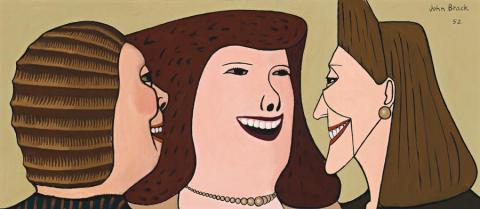THREE WOMEN, 1952
JOHN BRACK
oil on canvas
30.5 x 68.5 cm
signed and dated upper right: John Brack / 52
Private collection, Melbourne
Paintings and Drawings by John Brack, Peter Bray Gallery, Melbourne, 27 October – 5 November 1953, cat. 9
John Brack: A Retrospective Exhibition, National Gallery of Victoria, Melbourne, 10 December 1987 – 31 January 1988, cat. 8
John Brack, National Gallery of Victoria, Melbourne, 24 April – 9 August 2009, Art Gallery of South Australia, Adelaide, 2 October 2009 – 26 January 2010 (label attached verso)
Shore, A., 'We can all enjoy art like this', Argus, 28 October 1953, p. 4
Lindsay, R., McCaughey, P. and Hoff, U., John Brack:A Retrospective Exhibition, National Gallery of Victoria, Melbourne, 1987, pp. 14, 116, 138
Grishin, S., The Art of John Brack, Oxford University Press, Melbourne, 1990, vol. I, p. 43, vol. II, cat. o14, pp. 3, 84 (illus.)
Grant, K., John Brack, National Gallery of Victoria, Melbourne, 2009, pp. 96, 210, p. 97 (illus.)
John Brack's paintings of the early 1950s are unrivalled in their presentation of Melbourne life and mores of the time, culminating in the iconic Collins Street, 5pm 1955 in the collection of the NationalGallery of Victoria. Satire combines with sensitivity in his penetrating presentations, exposing such peculiarities as the six o'clock swill in The Bar 1954 (National Gallery of Victoria) and related works as Man in Pub 1953 (private collection). Even the nigh fanatical devotion to football gets a brief moment in Three of the Players 1953 - appropriately dressed in the Collingwood colours of black and white. Conformity was the byword; brown was the colour, and a weekly visit to the barber was part of the routine for men and boys. The Barber's Shop 1952 was Brack's first painting to be purchased by the National Gallery in 1953. It was hailed by Arnold Shore as one of the 'most original pictures exhibited inAustralia for some time'.1 Titles were disarmingly bland- The New House 1953, The Church 1954, The Block 1954- in sharp contrast to their probing visual imagery and multifaceted social commentary. While Mr Whitaker is named in Mr Whitaker's Small Business 1953, presentation is awesomely objective, evoking that sense of threat so powerfully felt in an Alfred Hitchcock film. But outward appearances are only one of the several levels on which Brack's paintings work. The Block in the National Gallery of Victoria is resonant of the Holocaust. The interior of the local butcher's shop takes on a nightmarish character- the chopping block anthropomorphically inclined as sacrificial altar, implements of torture suspended above, cruelty of clinical exactitude. The Tram 1952 profiles intimacy ominously interrupted by the elderly. Suburbia is the source and theme; but the delving is much deeper. The Short Street 1953 in the Art Gallery of Western Australia and Subdivision 1954 in the TarraWarra Museum of Art extend beyond drab monotony to embrace soulless emptiness and concern about relentless expansion. As in all his work of this time, Three Women 1952 is taken from the everyday that surrounded Brack. Perceptive observation of character is but part of the whole, open mouths and fashionable hairstyles probing the character of women and the perpetual puzzle they present to the male.
1. Shore, A., 'John Brack strikes an exciting new chord in Art. He rings the bell: He got into a lather...then he painted the barber', Australasian Post, Sydney, 5 March 1953, p. 37, quoted in Grishin, op. cit, vol. I, p. 35
DAVID THOMAS
